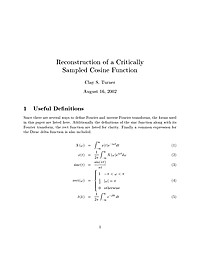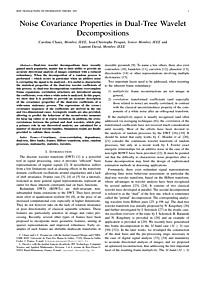
Noise covariance properties in Dual-Tree Wavelet Decompositions
Dual-tree wavelet decompositions have recently gained much popularity, mainly due to their ability to provide an accurate directional analysis of images combined with a reduced redundancy. When the decomposition of a random process is performed – which occurs in particular when an additive noise is corrupting the signal to be analyzed – it is useful to characterize the statistical properties of the dual-tree wavelet coefficients of this process. As dual-tree decompositions constitute overcomplete frame expansions, correlation structures are introduced among the coefficients, even when a white noise is analyzed. In this paper, we show that it is possible to provide an accurate description of the covariance properties of the dual-tree coefficients of a wide-sense stationary process. The expressions of the (cross-) covariance sequences of the coefficients are derived in the one and two-dimensional cases. Asymptotic results are also provided, allowing to predict the behaviour of the second-order moments for large lag values or at coarse resolution. In addition, the crosscorrelations between the primal and dual wavelets, which play a primary role in our theoretical analysis, are calculated for a number of classical wavelet families. Simulation results are finally provided to validate these results.
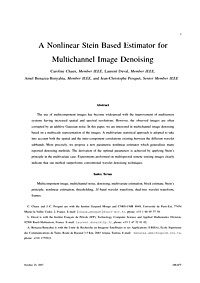
A Nonlinear Stein Based Estimator for Multichannel Image Denoising
The use of multicomponent images has become widespread with the improvement of multisensor systems having increased spatial and spectral resolutions. However, the observed images are often corrupted by an additive Gaussian noise. In this paper, we are interested in multichannel image denoising based on a multiscale representation of the images. A multivariate statistical approach is adopted to take into account both the spatial and the inter-component correlations existing between the different wavelet subbands. More precisely, we propose a new parametric nonlinear estimator which generalizes many reported denoising methods. The derivation of the optimal parameters is achieved by applying Stein’s principle in the multivariate case. Experiments performed on multispectral remote sensing images clearly indicate that our method outperforms conventional wavelet denoising techniques.
Code Acquisition using Smart Antennas with Adaptive Filtering Scheme for DS-CDMA Systems
Pseudo-noise (PN) code synchronizer is an essential element of direct-sequence code division multiple access (DS-CDMA) system because data transmission is possible only after the receiver accurately synchronizes the locally generated PN code with the incoming PN code. The code synchronization is processed in two steps, acquisition and tracking, to estimate the delay offset between the two codes. Recently, the adaptive LMS filtering scheme has been proposed for performing both code acquisition and tracking with the identical structure, where the LMS algorithm is used to adjust the FIR filter taps to search for the value of delay-offset adaptively. A decision device is employed in the adaptive LMS filtering scheme as a decision variable to indicate code synchronization, hence it plays an important role for the performance of mean acquisition time (MAT). In this thesis, only code acquisition is considered. In this thesis, a new decision device, referred to as the weight vector square norm (WVSN) test method, is devised associated with the adaptive LMS filtering scheme for code acquisition in DS-CDMA system. The system probabilities of the proposed scheme are derived for evaluating MAT. Numerical analyses and simulation results verify that the performance of the proposed scheme, in terms of detection probability and MAT, is superior to the conventional scheme with mean-squared error (MSE) test method, especially when the signal-to-interference-plus-noise ratio (SINR) is relatively low. Furthermore, an efficient and joint-adaptation code acquisition scheme, i.e., a smart antenna coupled with the proposed adaptive LMS filtering scheme with the WVSN test method, is devised for applying to a base station, where all antenna elements are employed during PN code acquisition. This new scheme is a process of PN code acquisition and the weight coefficients of smart antenna jointly and adaptively. Numerical analyses and simulation results demonstrate that the performance of the proposed scheme with five antenna elements, in terms of the output SINR, the detection probability and the MAT, can be improved by around 7 dB, compared to the one with single antenna case.

Fixed-Point Arithmetic: An Introduction
This document presents definitions of signed and unsigned fixed-point binary number representations and develops basic rules and guidelines for the manipulation of these number representations using the common arithmetic and logical operations found in fixed-point DSPs and hardware components.
Energy Profiling of DSP Applications, A Case Study of an Intelligent ECG Monitor
Proper balance of power and performance for optimum system organization requires precise profiling of the power consumption of different hardware subsystems as well as software functions. Moreover, power consumption of mobile systems is even more important, since the battery is a large portion of the overall size and weight of the system. Average power consumption is only a crude estimate of power requirements and battery life; a much better estimate can be made using dynamic power consumption. Dynamic power consumption is a function of the execution profile of the given application running on specific hardware platform. In this paper we introduce a new environment for energy profiling of DSP applications. The environment consists of a JTAG emulator, a high-resolution HP 3583A multimeter and a workstation that controls devices and stores the traces. We use Texas Instruments’ Real Time Data Exchange mechanism (RTDXÔ) to generate an execution profile and custom procedures for energy profile data acquisition using GPIB interface. We developed custom procedures to correlate and analyze both energy and execution profiles. The environment allows us to improve the system power consumption through changes in software organization and to measure real battery life for the given hardware, software and battery configuration. As a case study, we present the analysis of a real-time portable ECG monitor implemented using a Texas Instruments TMS320C5410-100 processor board, and a Del Mar PWA ECG Amplifier.
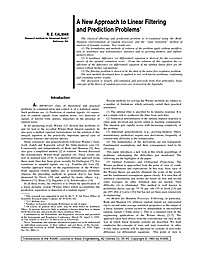
A New Approach to Linear Filtering and Prediction Problems
In 1960, R.E. Kalman published his famous paper describing a recursive solution to the discrete-data linear filtering problem. Since that time, due in large part to advances in digital computing, the Kalman filter has been the subject of extensive research and application, particularly in the area of autonomous or assisted navigation.
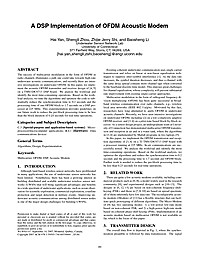
A DSP Implementation of OFDM Acoustic Modem
The success of multicarrier modulation in the form of OFDM in radio channels illuminates a path one could take towards high-rate underwater acoustic communications, and recently there are intensive investigations on underwater OFDM. In this paper, we implement the acoustic OFDM transmitter and receiver design of [4, 5] on a TMS320C6713 DSP board. We analyze the workload and identify the most time-consuming operations. Based on the workload analysis, we tune the algorithms and optimize the code to substantially reduce the synchronization time to 0.2 seconds and the processing time of one OFDM block to 1.7 seconds on a DSP processor at 225 MHz. This experimentation provides guidelines on our future work to reduce the per-block processing time to be less than the block duration of 0.23 seconds for real time operations.
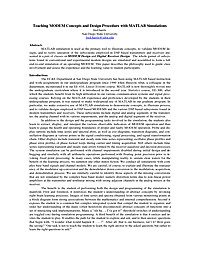
Teaching MODEM Concepts and Design Procedure with MATLAB Simulations
MATLAB simulation is used as the primary tool to illustrate concepts, to validate MODEM designs, and to vent' operation of the subsystems employed in DSP based transmitters and receivers presented in a pair of classes on MODEM Design and Digital Receiver Design. The whole gamut of subsystems found in conventional and experimental modem designs are simulated and assembled to form a full end-to-end simulation of an operating MODEM. This paper describes the philosophy used to guide class involvement and assess the experience and the learning value to student participants.
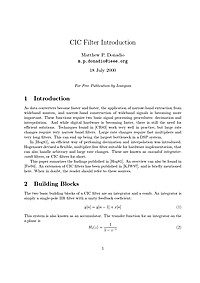
Cascaded Integrator-Comb (CIC) Filter Introduction
In the classic paper, "An Economical Class of Digital Filters for Decimation and Interpolation", Hogenauer introduced an important class of digital filters called "Cascaded Integrator-Comb", or "CIC" for short (also sometimes called "Hogenauer filters"). Here, Matthew Donadio provides a more gentle introduction to the subject of CIC filters, geared specifically to the needs of practicing DSP designers.
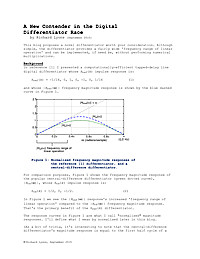
A New Contender in the Digital Differentiator Race
This blog proposes a novel differentiator worth your consideration. Although simple, the differentiator provides a fairly wide 'frequency range of linear operation' and can be implemented, if need be, without performing numerical multiplications.

Complex Down-Conversion Amplitude Loss
This article illustrates the signal amplitude loss inherent in a traditional complex down-conversion system. (In the literature of signal processing, complex down-conversion is also called "quadrature demodulation.")
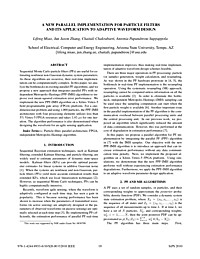
A NEW PARALLEL IMPLEMENTATION FOR PARTICLE FILTERS AND ITS APPLICATION TO ADAPTIVE WAVEFORM DESIGN
Sequential Monte Carlo particle filters (PFs) are useful for estimating nonlinear non-Gaussian dynamic system parameters. As these algorithms are recursive, their real-time implementation can be computationally complex. In this paper, we analyze the bottlenecks in existing parallel PF algorithms, and we propose a new approach that integrates parallel PFs with independent Metropolis-Hastings (PPF-IMH) algorithms to improve root mean-squared estimation error performance. We implement the new PPF-IMH algorithm on a Xilinx Virtex-5 field programmable gate array (FPGA) platform. For a onedimensional problem and using 1,000 particles, the PPF-IMH architecture with four processing elements utilizes less than 5% Virtex-5 FPGA resources and takes 5.85 μs for one iteration. The algorithm performance is also demonstrated when designing the waveform for an agile sensing application.
Code Acquisition using Smart Antennas with Adaptive Filtering Scheme for DS-CDMA Systems
Pseudo-noise (PN) code synchronizer is an essential element of direct-sequence code division multiple access (DS-CDMA) system because data transmission is possible only after the receiver accurately synchronizes the locally generated PN code with the incoming PN code. The code synchronization is processed in two steps, acquisition and tracking, to estimate the delay offset between the two codes. Recently, the adaptive LMS filtering scheme has been proposed for performing both code acquisition and tracking with the identical structure, where the LMS algorithm is used to adjust the FIR filter taps to search for the value of delay-offset adaptively. A decision device is employed in the adaptive LMS filtering scheme as a decision variable to indicate code synchronization, hence it plays an important role for the performance of mean acquisition time (MAT). In this thesis, only code acquisition is considered. In this thesis, a new decision device, referred to as the weight vector square norm (WVSN) test method, is devised associated with the adaptive LMS filtering scheme for code acquisition in DS-CDMA system. The system probabilities of the proposed scheme are derived for evaluating MAT. Numerical analyses and simulation results verify that the performance of the proposed scheme, in terms of detection probability and MAT, is superior to the conventional scheme with mean-squared error (MSE) test method, especially when the signal-to-interference-plus-noise ratio (SINR) is relatively low. Furthermore, an efficient and joint-adaptation code acquisition scheme, i.e., a smart antenna coupled with the proposed adaptive LMS filtering scheme with the WVSN test method, is devised for applying to a base station, where all antenna elements are employed during PN code acquisition. This new scheme is a process of PN code acquisition and the weight coefficients of smart antenna jointly and adaptively. Numerical analyses and simulation results demonstrate that the performance of the proposed scheme with five antenna elements, in terms of the output SINR, the detection probability and the MAT, can be improved by around 7 dB, compared to the one with single antenna case.
Energy Profiling of DSP Applications, A Case Study of an Intelligent ECG Monitor
Proper balance of power and performance for optimum system organization requires precise profiling of the power consumption of different hardware subsystems as well as software functions. Moreover, power consumption of mobile systems is even more important, since the battery is a large portion of the overall size and weight of the system. Average power consumption is only a crude estimate of power requirements and battery life; a much better estimate can be made using dynamic power consumption. Dynamic power consumption is a function of the execution profile of the given application running on specific hardware platform. In this paper we introduce a new environment for energy profiling of DSP applications. The environment consists of a JTAG emulator, a high-resolution HP 3583A multimeter and a workstation that controls devices and stores the traces. We use Texas Instruments’ Real Time Data Exchange mechanism (RTDXÔ) to generate an execution profile and custom procedures for energy profile data acquisition using GPIB interface. We developed custom procedures to correlate and analyze both energy and execution profiles. The environment allows us to improve the system power consumption through changes in software organization and to measure real battery life for the given hardware, software and battery configuration. As a case study, we present the analysis of a real-time portable ECG monitor implemented using a Texas Instruments TMS320C5410-100 processor board, and a Del Mar PWA ECG Amplifier.
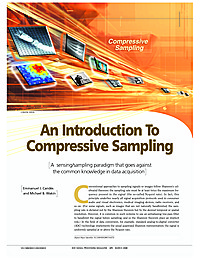
An Introduction To Compressive Sampling
This article surveys the theory of compressive sensing, also known as compressed sensing or CS, a novel sensing/sampling paradigm that goes against the common wisdom in data acquisition.
An FPGA Implementation of Hierarchical Motion Estimation for Embedded Oject Tracking
This paper presents the hardware implementation of an algorithm developed to provide automatic motion detection and object tracking functionality embedded within intelligent CCTV systems. The implementation is targeted at an Altera Stratix FPGA making full use of the dedicated DSP resource. The Altera Nios embedded processor provides a platform for the tracking control loop and generic Pan Tilt Zoom camera interface. This paper details the explicit functional stages of the algorithm that lend themselves to an optimised pipelined hardware implementation. This implementation provides maximum data throughput, providing real-time operation of the described algorithm, and enables a moving camera to track a moving object in real time.
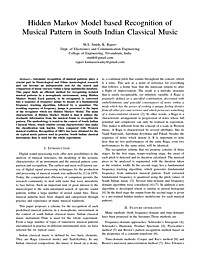
Hidden Markov Model based recognition of musical pattern in South Indian Classical Music
Automatic recognition of musical patterns plays a crucial part in Musicological and Ethno musicological research and can become an indispensable tool for the search and comparison of music extracts within a large multimedia database. This paper finds an efficient method for recognizing isolated musical patterns in a monophonic environment, using Hidden Markov Model. Each pattern, to be recognized, is converted into a sequence of frequency jumps by means of a fundamental frequency tracking algorithm, followed by a quantizer. The resulting sequence of frequency jumps is presented to the input of the recognizer which use Hidden Markov Model. The main characteristic of Hidden Markov Model is that it utilizes the stochastic information from the musical frame to recognize the pattern. The methodology is tested in the context of South Indian Classical Music, which exhibits certain characteristics that make the classification task harder, when compared with Western musical tradition. Recognition of 100% has been obtained for the six typical music pattern used in practise. South Indian classical instrument, flute is used for the whole experiment.
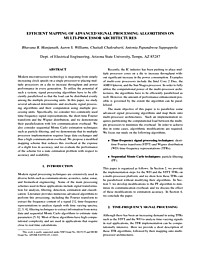
EFFICIENT MAPPING OF ADVANCED SIGNAL PROCESSING ALGORITHMS ON MULTI-PROCESSOR ARCHITECTURES
Modern microprocessor technology is migrating from simply increasing clock speeds on a single processor to placing multiple processors on a die to increase throughput and power performance in every generation. To utilize the potential of such a system, signal processing algorithms have to be efficiently parallelized so that the load can be distributed evenly among the multiple processing units. In this paper, we study several advanced deterministic and stochastic signal processing algorithms and their computation using multiple processing units. Specifically, we consider two commonly used time-frequency signal representations, the short-time Fourier transform and the Wigner distribution, and we demonstrate their parallelization with low communication overhead. We also consider sequential Monte Carlo estimation techniques such as particle filtering, and we demonstrate that its multiple processor implementation requires large data exchanges and thus a high communication overhead. We propose a modified mapping scheme that reduces this overhead at the expense of a slight loss in accuracy, and we evaluate the performance of the scheme for a state estimation problem with respect to accuracy and scalability.

Efficient Digital Fiilters
What would you do in the following situation? Let ’ s say you are diagnosing a DSP system problem in the field. You have your trusty laptop with your development system and an emulator. You figure out that there was a problem with the system specifications and a symmetric FIR filter in the software won ’ t do the job; it needs reduced passband ripple, or maybe more stopband attenuation. You then realize you don ’ t have any filter design software on the laptop, and the customer is getting angry. The answer is easy: You can take the existing filter and sharpen it. Simply stated, filter sharpening is a technique for creating a new filter from an old one [1] – [3] . While the technique is almost 30 years old, it is not generally known by DSP engineers nor is it mentioned in most DSP textbooks.








